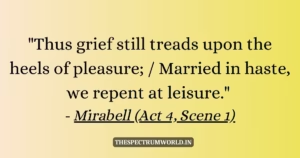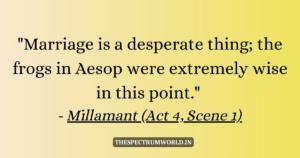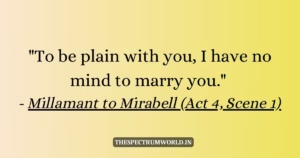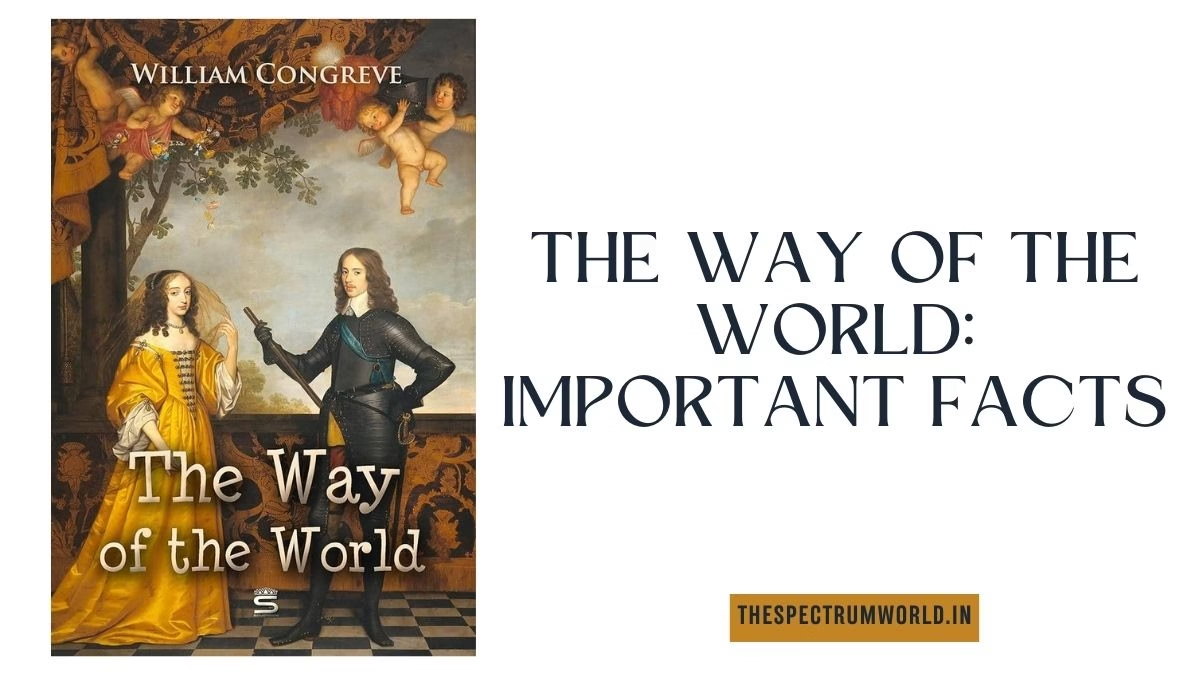The Way of the World: Important Facts
“The Way of the World” is a play written by William Congreve, first performed in 1700. It is considered one of the greatest works of Restoration comedy, known for its witty dialogue, complex characters, and satire of the social norms of the time.
The play revolves around the story of Mirabell and Millamant, two lovers navigating the complexities of relationships, family expectations, and social status. Mirabell seeks to win Millamant’s hand in marriage while facing opposition from her aunt, Lady Wishfort, and other suitors.
Table of Contents

Act-wise Summary of The Way of the World:
Act 1
The play introduces Mirabell and Millamant’s complicated relationship, with Mirabell seeking to win Millamant’s hand in marriage. Lady Wishfort’s opposition and the presence of other suitors, like Sir Wilfull Witwoud, complicate matters.
Act 2
Mirabell devises a plan to win Lady Wishfort’s approval by thwarting the plans of Mrs. Marwood, a rival who seeks to marry Sir Wilfull to Millamant. Meanwhile, the relationships between characters are revealed, showcasing their motivations and desires.
Act 3
The plot thickens as Mirabell’s scheme unfolds, involving disguises, letters, and manipulation. Tensions rise among the characters, particularly between Mirabell and Mrs. Marwood.
Act 4
The complications and misunderstandings reach a peak, with Lady Wishfort’s feelings and opinions being manipulated. Mirabell’s plan seems to be working, but new obstacles arise.
Act 5
The play reaches its climax as the characters’ true intentions are revealed. Mirabell’s scheme is successful, and he wins Millamant’s hand in marriage. The play concludes with a sense of resolution and new beginnings for the characters.
Main Characters in The Way of the World:
- Mirabell: The protagonist, a charming and clever young man-about-town who is in love with Millamant. He’s determined to win her hand in marriage despite Lady Wishfort’s disapproval.
- Millamant: The female lead, a beautiful, witty, and strong-willed young woman who is the ward of Lady Wishfort. She’s in love with Mirabell and navigates the complexities of their relationship with cleverness and poise.

Supporting Characters:
- Lady Wishfort: A wealthy, aging widow and Millamant’s aunt, who seeks to control Millamant’s marriage choices for her own benefit. She’s vain, silly, and often manipulated by those around her.
- Fainall: A deceitful and greedy husband who is having an affair with Mrs. Marwood. He’s plotting to gain control of his wife’s and mother-in-law’s estates.
- Mrs. Fainall (Arabella): Lady Wishfort’s daughter and Millamant’s cousin, who is clever and cautious. She helps Mirabell in his plans to marry Millamant.
- Mrs. Marwood: Fainall’s lover and Mrs. Fainall’s friend, who is cunning and manipulative. She seeks to ruin the happiness of others for her own gain.
Servants and Other Characters:
- Foible: Lady Wishfort’s servant, who is quick-witted and deceitful. She assists Mirabell in his plans and helps expose Fainall and Marwood’s deceit.
- Waitwell: Mirabell’s servant, who agrees to marry Foible and impersonate Mirabell’s uncle to help his master’s plans.
- Witwoud: A foolish and self-important man who prides himself on his wit and charm. He’s a friend of Petulant and a cousin of Millamant.
- Petulant: A boisterous and ill-humored young man who is a friend of Witwoud. He’s known for his tactlessness and foolish behavior.
- Sir Wilfull Witwoud: Lady Wishfort’s nephew from the countryside, who is good-natured but unsophisticated. He’s a potential suitor for Millamant’s hand in marriage.
Themes in The Way of the World:
- Love and Marriage: The play explores the tension between romantic love and societal expectations in marriage.
- Social Class and Status: Congreve satirizes the social hierarchy and the pretensions of the upper class.
- Deception and Appearance vs. Reality: Characters use disguise, manipulation, and deception to achieve their goals, highlighting the disparity between appearance and reality.

Quotes from The Way of the World:
- “Thus grief still treads upon the heels of pleasure; / Married in haste, we repent at leisure.” – Mirabell (Act 4, Scene 1)
- “A plague of sighing and grinning! Instead of making a pretty pair of lovers, you are become a dismal pair of stage philosophers.” – Mirabell to Millamant (Act 4, Scene 1)
- “O fie, fie, fie upon thee, thou damnable fellow! thou art as pragmatical as a decayed beauty.” – Mirabell to Witwoud (Act 3, Scene 1)
- “Marriage is a desperate thing; the frogs in Aesop were extremely wise in this point.” – Millamant (Act 4, Scene 1)
- “You are merry, sir; but I fear I shall not be able to take your jest.” – Lady Wishfort (Act 2, Scene 1)
- “To be plain with you, I have no mind to marry you.” – Millamant to Mirabell (Act 4, Scene 1)
Style and Legacy of William Congreve:
- Witty Dialogue: The play is renowned for its clever language, repartee, and satire.
- Complex Characters: Congreve crafts intricate characters with distinct personalities and motivations.
“The Way of the World” remains a significant work in the canon of English literature, offering insights into the social commentary and wit of the Restoration era. Its themes and characters continue to resonate with audiences today, making it a timeless masterpiece of comedic literature.

Comedy of Manners: A Literary Genre:
Comedy of manners is a theatrical genre that satirizes the social behaviors, customs, and hypocrisy of the upper class. It often features:
- Witty dialogue: Quick-witted conversations, repartee, and clever wordplay.
- Satire and social commentary: The genre critiques the social norms, values, and morals of the aristocracy.
- Intricate plots: Complex storylines with mistaken identities, deceptions, and misunderstandings.
- Characters with distinct personalities: Well-defined characters with unique traits, often exaggerated for comedic effect.
Key Features of Comedy of Manners:
- Focus on social class: The genre often explores the lives and relationships of the upper class.
- Moral ambiguity: Characters may engage in questionable behavior, highlighting the hypocrisy of societal norms.
- Humor and irony: The genre uses humor, irony, and absurdity to critique social conventions.
Examples of Comedy of Manners:
- The Way of the World by William Congreve
- The School for Scandal by Richard Brinsley Sheridan
Read more: Volpone by Ben Jonson: Important Facts






